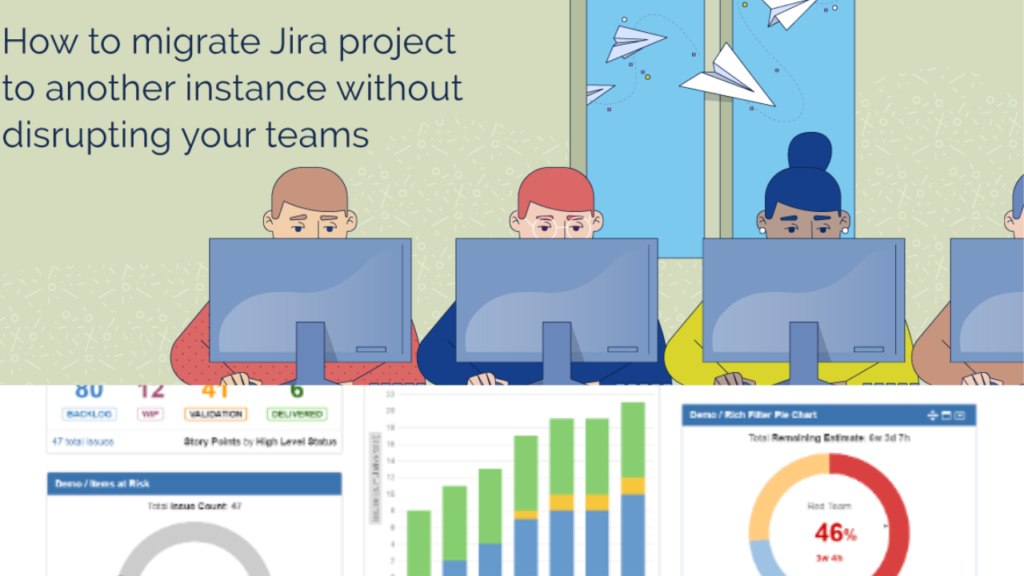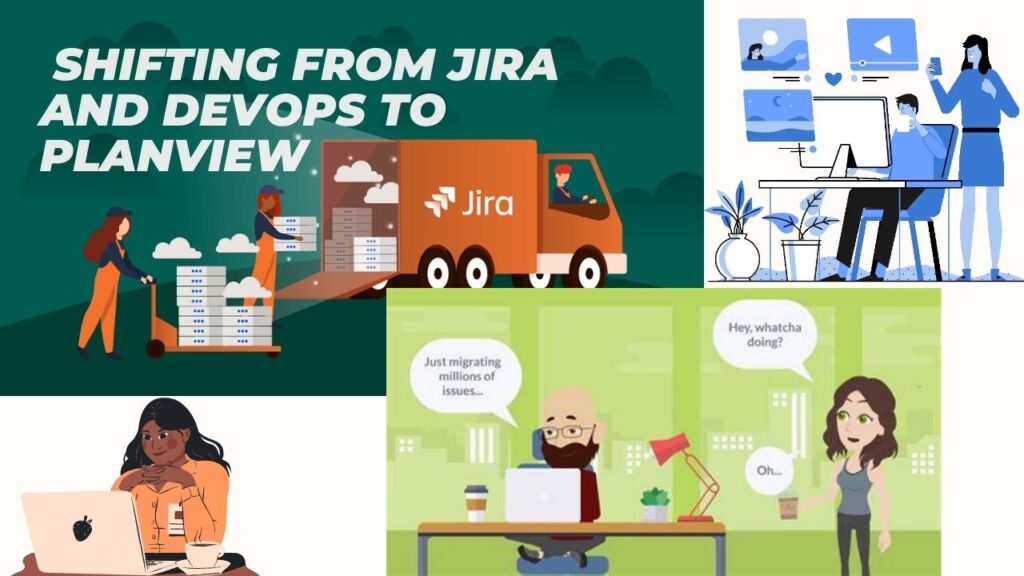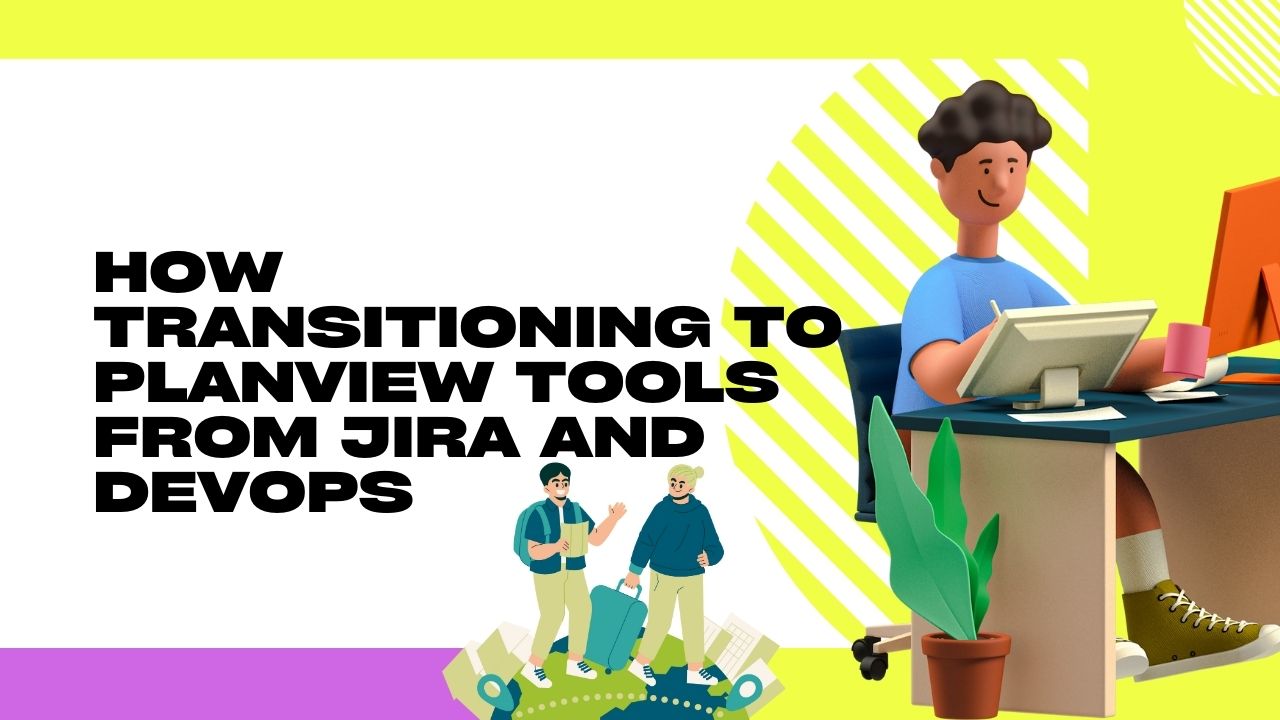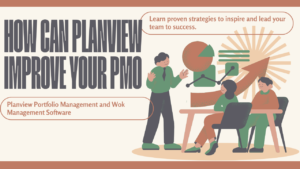Transition from Jira and DevOps to Planview tools is a strategic leap toward optimizing project and portfolio management. Begin by assessing the need for change, identifying limitations in existing tools. Craft a migration strategy involving key stakeholders, mapping data, and aligning processes. Customize Planview tools to match specific organizational needs while ensuring scalability. Seamlessly integrate the new tools into workflows, ensuring maximum user adoption. Plan and communicate the transition, implement a pilot phase, and gather user feedback. Celebrate milestones and measure success using defined metrics. Through this journey, Planview tools redefine efficiency, collaboration, and decision-making, propelling your organization into a new era of excellence.
Table of Contents
Introduction: Transitioning from Jira and DevOps
Transitioning from Jira and DevOps marks a strategic evolution in project and portfolio management. This shift involves migrating from familiar tools to the dynamic capabilities of Planview, unlocking enhanced collaboration, data-driven insights, and streamlined workflows. As organizations embrace this transition, they bridge gaps in resource allocation, portfolio oversight, and decision-making. By bidding adieu to limitations and welcoming Planview tools, teams can harness a comprehensive platform tailored to their unique needs. This transition isn’t just a change of tools; it’s a strategic journey toward efficiency, innovation, and improved project outcomes.

Paving the Path to Enhanced Project Management-Transition from Jira and DevOps
In the fast-paced realm of modern business, the tools we wield can make all the difference. Enter the strategic migration from Jira and DevOps to the versatile capabilities of Planview tools. This article Transition from Jira and DevOps embarks on a journey through this transformation, exploring the catalysts, challenges, and compelling benefits that beckon organizations toward this shift.
I. Evaluating the Need for Transition: Navigating Change
In this phase, Transition from Jira and DevOps organizations embark on a pivotal journey of assessing their existing tools, Jira and DevOps, and the catalysts driving the transition to Planview. Challenges in achieving holistic project visibility, efficient resource allocation, and comprehensive portfolio management come to the fore. This evaluation process is a precursor to a transformative shift, where the limitations of current tools are recognized as stepping stones toward a future of enhanced collaboration, streamlined workflows, and data-driven decision-making. Navigating this change requires a deep understanding of both present pain points and the promising horizons Planview tools offer.
Challenges with Current Tools: Transitioning from Jira and DevOps Breaking Through Limitations
The incumbent tools, Transition from Jira and DevOps, have their strengths, but no tool is immune to limitations. Jira’s task-focused prowess might falter when it comes to providing a panoramic view of project portfolios. DevOps, while adept in the development lifecycle, might not provide the comprehensive project management scope that Planview offers. Recognizing these gaps sets the stage for a more holistic solution.
- Limited Scope: Jira and DevOps excel in their niches, but they might fall short in offering a panoramic view of project portfolios.
- Resource Allocation Bottlenecks: Jira’s task-focused approach may hinder optimal resource allocation, leading to bottlenecks.
- Holistic Project Oversight: DevOps, while proficient in development, might lack comprehensive project management capabilities.
Desired Outcomes: Setting the Vision for Transformation
Organizations are rarely motivated by change for its own sake. It’s the promise of something better that drives them. In the realm of Planview tools, lies the potential for amplified visibility, smoother collaboration, optimized resource allocation, and strategic decision-making based on data-driven insights.
Example: Consider a marketing agency immersed in the world of Transition from Jira and DevOps. While these tools excel in managing tasks and development pipelines, the agency grapples with connecting projects to overarching strategic objectives. Resource allocation remains a challenge, often leading to bottlenecks. By embracing Planview tools, the agency envisions a landscape where projects align seamlessly with the company’s big picture, and resource allocation is a well-orchestrated symphony.
In the upcoming section, Transition from Jira and DevOps we’ll delve into the vital steps of strategizing this migration. From meticulous planning to seamless execution, we’ll unveil how organizations can lay the foundation for a successful transition to Planview tools. Stay with us to uncover the strategic blueprint that ensures a seamless journey.
II. Defining the Migration Strategy: Forging the Path Ahead
Once the decision to Transition from Jira and DevOps has been made, the next crucial step is to chart a well-defined migration strategy. This strategy becomes the guiding compass that ensures a seamless and successful transition from Jira and DevOps to the dynamic realm of Planview tools.
Stakeholder Involvement: A Multifaceted Approach to Success
At the heart of a successful migration strategy lies stakeholder involvement. Engaging key stakeholders from various departments is not just a step – it’s a fundamental principle that infuses the transition with the expertise, insights, and alignment needed for success. Collaboration and cross-functional perspectives from IT, development, project management, and other relevant departments bring diverse viewpoints to the table.
Key Points:
- Holistic Insight: Stakeholders provide a holistic understanding of the organization’s needs, challenges, and goals.
- Alignment: Involvement of stakeholders ensures that the migration strategy aligns with overarching organizational objectives.
- Effective Planning: Collaborative planning leads to comprehensive decision-making, reducing the likelihood of oversight.
Data Assessment: Laying the Foundation for Transition
Transition from Jira and DevOps is built upon existing data, workflows, and processes. A thorough assessment of these elements within Jira and DevOps serves as a foundation for a successful migration. Understanding how data is organized, how processes are mapped, and how workflows function provides crucial insights that shape the migration strategy.
Key Points:
- Data Mapping: Mapping data sources, attributes, and relationships helps identify what needs to be migrated.
- Process Analysis: Evaluating workflows and processes highlights potential areas for improvement and optimization.
- Identifying Dependencies: Recognizing interdependencies helps avoid disruptions during migration and integration.
Example: Imagine a software development company undergoing this transition. Involving stakeholders from IT, development, and project management ensures that the migration strategy is tailored to their respective needs. Additionally, by assessing existing data in Jira and DevOps, the company gains insights into data structures, process bottlenecks, and potential areas for improvement. This knowledge sets the stage for a well-informed, efficient migration strategy that considers the entire organizational landscape.
In the upcoming section, we delve deeper into the process of mapping existing processes to the capabilities of Planview tools. Join us as we unveil the strategic steps that bridge the present with a transformative future.
III. Mapping Processes to Planview: Bridging the Present with the Future
With a solid migration strategy in place, the journey from Transition from Jira and DevOps to Planview tools gains momentum. In this section, we dive into the crucial process of mapping existing processes to the dynamic capabilities of Planview tools.
Process Alignment: Orchestrating Seamless Transition
The heart of a successful migration lies in the alignment of existing workflows and processes with the functionalities of Planview tools. This meticulous alignment ensures a seamless transition where familiar processes seamlessly integrate with the enhanced capabilities that Planview offers.
Key Points:
- Workflow Assessment: Carefully assess existing workflows to identify points of convergence and divergence.
- Functional Parity: Identify equivalent functionalities in Planview tools that cater to the same needs as in Jira and DevOps.
- Process Enhancements: Leverage the transition as an opportunity to optimize and improve processes, streamlining operations.
Customization: Crafting Tools Tailored to You
Planview tools offer not just a suite of capabilities, but a canvas for customization. Every organization has its unique DNA, and Planview acknowledges that. Highlight the ability to mold Planview tools to match specific needs, ensuring a toolset that aligns precisely with the organization’s requirements.
Key Points:
- Adapting Workflows: Customize workflows to replicate existing processes, ensuring a comfortable transition for users.
- User-Centric Design: Tailor Planview tools to align with the preferences and habits of your team members.
- Optimized User Experience: Customization enhances user engagement and accelerates adoption of the new tools.
Example: Picture an IT department within a large corporation. As they migrate to Planview tools, they find that their agile development process in Jira can be seamlessly mirrored in Planview’s Agile Project Management module. Additionally, they tap into Planview’s customization capabilities to design dashboards that visualize data in ways that resonate with their team’s unique needs.
In the upcoming section, Transition from Jira and DevOps we venture into the realm of data migration and integration, exploring the intricate process of transferring data from Jira and DevOps to Planview tools. Join us as we unravel the art of data harmonization in the transition journey.
IV. Data Migration and Integration: Crafting a Unified Landscape
As the transition journey advances, the spotlight now turns to data migration and integration—a pivotal phase that ensures a seamless transfer of information and a harmonious coexistence with existing systems. In this section, we delve into the intricacies of this process.
Data Migration Strategy: Bridging the Past with the Present
The heart of data migration lies in meticulous planning and execution. A well-defined data migration strategy is essential for ensuring that essential data from Transition from Jira and DevOps finds a new home within Planview tools.
Key Points:
- Data Inventory: Create a comprehensive inventory of data to be migrated, identifying what is crucial for ongoing operations.
- Data Mapping: Map data fields and structures between Jira, DevOps, and Planview tools for smooth translation.
- Data Validation: Rigorously validate migrated data to ensure accuracy, completeness, and consistency.
Integration Considerations: Seamlessly Coexisting Ecosystems
Modern organizations often rely on a multitude of software tools. Ensuring that Planview tools integrate seamlessly with existing systems is paramount to prevent silos and enable cross-functional collaboration.
Key Points:
- Integration Framework: Explore integration options, such as APIs or middleware, to facilitate data flow between Planview and other systems.
- Process Mapping: Identify touchpoints where data needs to be synchronized between Planview and existing tools like CRM, ERP, or communication platforms.
- Real-Time Data Exchange: Aim for real-time or near-real-time data exchange to maintain up-to-date insights.
Example: Consider a project-driven organization that uses Jira for issue tracking and DevOps for development. As they transition to Planview tools, their data migration strategy involves transferring essential project data, including tasks, timelines, and resource allocation, while leaving behind irrelevant or redundant data. Simultaneously, they set up integrations that allow seamless data exchange between Planview and their existing CRM, ensuring that customer-related data remains consistent across platforms.
In the forthcoming section, Transition from Jira and DevOps,we illuminate the vital importance of planning and communication during this transition. Join us as we delve into the art of harmonizing minds and processes for a successful journey ahead.
V. Planning and Communication: Forging a Path of Clarity and Confidence
As the Transition from Jira and DevOps unfolds, two pillars emerge as indispensable for success: meticulous planning and transparent communication. In this section, we illuminate the significance of these pillars and how they guide organizations through the transformation journey.
Project Timeline: Charting the Journey Ahead
The compass that navigates the Transition from Jira and DevOps is a well-crafted project timeline. It provides a roadmap, ensuring that the migration process proceeds systematically and within realistic timeframes.
Key Points:
- Sequential Steps: Break down the migration process into distinct phases and milestones.
- Resource Allocation: Allocate resources judiciously to each phase to avoid bottlenecks.
- Flexibility: Account for unforeseen challenges and allow flexibility for adjustments without derailing the timeline.
Change Management: Navigating the Human Element
Transition from Jira and DevOps to new tools can be met with resistance or apprehension from team members. Effective change management is essential to navigate this aspect of the Transition from Jira and DevOps.
Key Points:
- Stakeholder Involvement: Engage stakeholders early on, communicating the rationale behind the transition and its benefits.
- Clear Communication: Provide consistent, clear, and transparent communication at every stage of the transition.
- Addressing Concerns: Acknowledge concerns and address them openly, fostering a sense of involvement and ownership.
Example: Imagine a software development team on the verge of transitioning. By creating a project timeline, they establish a roadmap with designated periods for data migration, integration, testing, and training. This timeline not only guides their actions but also instills a sense of purpose and direction. Additionally, the team employs change management strategies by hosting regular town hall sessions, addressing questions, and conducting workshops to help team members familiarize themselves with Planview tools.
In the forthcoming section, Transition from Jira and DevOps, we delve into the realm of training and onboarding, where empowering team members becomes a key aspect of a successful transition. Join us as we unravel the strategies for ensuring a seamless adaptation to the new toolscape.
VI. Training and Onboarding: Empowering the Torchbearers of Transformation
Transition from Jira and DevOps to new tools isn’t just about technology—it’s about enabling the team to wield these tools effectively. In this section, we underscore the critical role of training and onboarding in ensuring a seamless transition.
Training Programs: Guiding the Journey to Proficiency
Introducing a new toolset requires a comprehensive approach to training. Well-structured training programs ensure that team members understand the nuances of Planview tools and confidently navigate their functionalities.
Key Points:
- Role-Based Training: Tailor training programs based on roles to ensure relevancy and efficiency.
- Hands-On Learning: Emphasize practical, hands-on training that enables users to apply concepts in real-world scenarios.
- Continuous Learning: Offer ongoing training sessions to keep users updated with new features and enhancements.
User Support: Nurturing a Culture of Assistance
Transition from Jira and DevOps periods can be accompanied by queries and uncertainties. Providing reliable user support is pivotal to ensure that team members feel supported as they adapt to the new tools and workflows.
Key Points:
- Helpdesk Resources: Set up a dedicated helpdesk to address user queries and concerns promptly.
- User Communities: Foster user communities where team members can share insights, tips, and best practices.
- Feedback Channels: Encourage users to provide feedback on challenges and suggestions for improvement.
Example: Let’s consider a marketing team embarking on this transition. The team designs role-specific training programs, where content creators focus on content management features, while project managers delve into project tracking capabilities. Additionally, they establish a user support portal where team members can submit queries and receive quick responses from experts. This seamless integration of training and support accelerates the onboarding process and boosts confidence in using Planview tools effectively.
In the upcoming section, we address the concept of pilot testing and gathering feedback—an integral part of fine-tuning the transition journey for ultimate success. Join us as we unveil the power of iteration and adaptation.
VII. Pilot Testing and Feedback: Refining the Transition Journey
As the Transition from Jira and DevOps gains momentum, the concept of pilot testing and gathering feedback emerges as a crucial step to ensure a transition that’s not just smooth, but also tailored to the unique needs of the organization. In this section, we delve into this iterative process.
Pilot Phase: A Prelude to Widespread Success
Before full-scale implementation, a pilot phase offers a controlled environment for testing the waters. This phase involves a select group of users who explore Planview tools, providing insights that inform refinements.
Key Points:
- Selecting the Team: Choose a cross-functional group that represents different roles and responsibilities.
- Focused Objectives: Set clear objectives for the pilot phase, whether it’s testing specific functionalities or evaluating usability.
- Feedback Loop: Establish a feedback mechanism that encourages participants to share their experiences and challenges.
Feedback Collection: Voices that Shape the Transition
User feedback is the cornerstone of improvement. Collecting feedback systematically during the pilot phase and beyond ensures that user concerns are addressed and the transition aligns better with user needs.
Key Points:
- Surveys and Questionnaires: Design surveys to gather quantitative and qualitative insights from pilot users.
- User Interviews: Conduct one-on-one interviews to delve deeper into user experiences and identify pain points.
- Feedback Integration: Use collected feedback to make iterative improvements to processes, workflows, and user training.
Example: Imagine an engineering team embracing the pilot phase. A select group of engineers, project managers, and team leads explore Planview tools to manage their projects. Through weekly feedback sessions and surveys, they provide insights into tool functionalities, ease of use, and areas of improvement. This feedback informs adjustments that enhance the experience of both pilot users and the larger team during full implementation.
In the following section, we venture into the realm of full transition and continuous improvement, where the culmination of efforts unfolds into a new era of project and portfolio management. Join us as we explore the climax of the transition journey.
VIII. Full Transition and Continuous Improvement: Embracing the New Horizon
As the Transition from Jira and DevOps journey approaches its pinnacle, the spotlight shifts to the full implementation and the ongoing process of continuous improvement. In this section, we explore the critical steps that guide organizations toward a transformative future.
Full Implementation: Unveiling the New Dawn
The Transition from Jira and DevOps that began as a spark of change now unfolds into a complete transformation. The process of rolling out Planview tools to the entire organization requires careful orchestration to ensure a seamless adoption.
Key Points:
- Communication Plan: Craft a comprehensive communication plan that informs all stakeholders about the Transition from Jira and DevOps process.
- Training Completion: Ensure that all users have undergone the requisite training before the full implementation.
- Data Migration Completion: Verify the successful migration of relevant data from Jira and DevOps to Planview tools.
- Support Readiness: Have a dedicated support team in place to address any issues that may arise during the initial phases of implementation.
Continuous Improvement: Navigating the Winds of Change
The Transition from Jira and DevOps marks a new beginning, but the journey is far from over. The culture of continuous improvement ensures that Planview tools evolve in tandem with organizational needs.
Key Points:
- Regular Assessment: Regularly evaluate how Planview tools are meeting organizational objectives and addressing pain points.
- Feedback Utilization: Use user feedback and insights gained from usage to drive refinements and enhancements.
- Adapting to Change: Embrace the agility to adapt tools and workflows as the organization’s dynamics evolve.
Example: Visualize a sales team stepping into the realm of full implementation. After the successful pilot phase, they execute a well-communicated transition plan, ensuring that every team member is aligned with the change. Once Planview tools are fully integrated, the team doesn’t rest on its laurels. They establish a culture of continuous improvement, using regular user feedback to fine-tune processes, customize dashboards, and refine reporting templates to better suit the team’s evolving requirements.
In the concluding section, we wrap up this journey by celebrating the achievements and highlighting the transformative impact of Planview tools on project and portfolio management. Join us for the final crescendo that brings this transition journey to a resounding close.
IX. Celebrating Success and Measuring Impact: Commemorating Transformation
As the Transition from Jira and DevOps journey reaches its triumphant finale, it’s time to pause and reflect on the achievements, impact, and transformation that Planview tools have ushered in. In this section, we shine a spotlight on celebrating milestones and gauging the transformation’s significance.
Success Metrics: Gauging the Transformative Power
To truly measure the impact of the Transition from Jira and DevOps, organizations need to define success metrics that reflect the goals they set out to achieve. These metrics serve as tangible markers of progress and provide insights into the effectiveness of the migration.
Key Points:
- Enhanced Visibility: Measure the improvement in project visibility across the organization.
- Resource Optimization: Evaluate the efficiency of resource allocation and utilization.
- Decision-Making: Analyze how data-driven decision-making has been enhanced.
- User Adoption: Track the rate of user adoption and engagement with Planview tools.
Acknowledging Achievements: A Toast to the Journey
Transitioning from Jira and DevOps to Planview tools is no small feat. Acknowledging and celebrating the team’s efforts during this transformation journey not only boosts morale but also cements a sense of accomplishment.

Key Points:
- Team Recognition: Recognize and celebrate individual and team contributions to the transition.
- Sharing Success Stories: Share stories of successful project outcomes made possible by Planview tools.
- Learning from Challenges: Embrace challenges as opportunities for growth, and celebrate the resilience displayed by the team.
Example: Envision a project management team, having transitioned successfully. They define success metrics such as a 20% increase in project delivery efficiency, a 15% reduction in resource allocation time, and a 30% improvement in cross-functional collaboration. As they achieve these milestones, the organization celebrates with a company-wide event, acknowledging the hard work, adaptability, and dedication that brought about this transformative change.
In the final section, we bring this journey to a close with a call to action, encouraging readers to embark on their own transformational endeavors with Planview tools. Join us as we bid adieu to the transition journey and set the stage for new horizons.
Conclusion: Embrace the Future with Planview-Transition from Jira and DevOps
How to Transition from Jira and DevOps- The journey from contemplating change to executing a seamless transition has been one of transformation and empowerment. As we conclude this guide, let’s recap the path we’ve traversed, from considering the transition to successfully implementing Planview tools. This journey has illuminated the potential for enhanced project and portfolio management, igniting a new era of efficiency, collaboration, and data-driven decision-making.
From evaluating the need for Transition from Jira and DevOps, mapping processes, and engaging stakeholders, to meticulous data migration, training, and continuous improvement, every step has been carefully crafted to guide organizations toward success. By weaving the tapestry of stakeholder involvement, customization, and thorough planning, we’ve showcased the way forward.
Planview tools have emerged as the catalysts for change, transforming challenges into opportunities and aspirations into reality. The seamless coexistence of data migration and integration, the empowerment of the team through training and support, and the iterative refinement have all paved the way for a new dawn.
But this is not just an end- How to Transition from Jira and DevOps—it’s the beginning of a transformative journey. With the metrics of success as our guide, we measure the strides we’ve taken. And as we acknowledge and celebrate every achievement, we set the stage for a culture of continuous improvement.
So, to all those seeking a new horizon in project and portfolio management, we encourage you to explore the dynamic offerings of Planview. It’s a world where efficiency meets collaboration, where data illuminates’ decisions, and where seamless integration becomes reality. Embark on your own transformative journey, where possibilities abound, and success becomes a collective achievement.
Transition from Jira and DevOps with Planview, the future is bright, and the journey is yours to embrace.



